
[tif] overview
2005 P. Suetterlin
View from the Roque de los Muchachos, the highest point of La Palma (2372m). From left: William Herschel Telescope, DOT, Liverpool Telescope, Swedish 1-m Solar Telescope, Isaac Newton Telescope, Jacobus Kapteyn Telescope. The codeso, a broom endemic to La Palma, blooms yellow in spring.
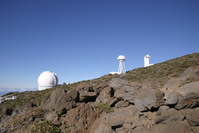
[jpg] overview
2005 T. van Werkhoven
View from the Roque de los Muchachos. From left: William Herschel Telescope, DOT, Swedish 1-m Solar Telescope.
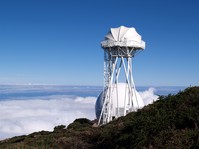
[jpg] DOT and WHT
2005 A. Kucera
The DOT and the WHT, one Dutch and one British with Dutch partnership (but both with Dutch leaders called Rutten).
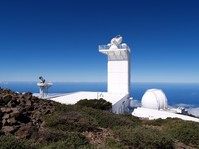
[jpg] DOT and SST co-observing
2005 A. Kucera
The DOT and the SST co-pointed in tandem observation.
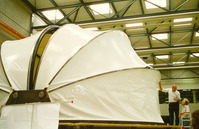
[jpg] DOT canopy
1995 F.C.M. Bettonvil
The foldaway DOT canopy in the workshop of Technical University Delft. It consists of a heavy fabric mounted on steel ribs. A larger copy has in the meantime been installed on Tenerife for the future German 1.5m solar telescope GREGOR.
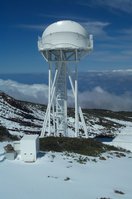
[jpg] DOT closed
2002 R.H. Hammerschlag
In bad weather conditions the foldable DOT canopy is closed. It withstands hurricanes and sheds snow without problems. However, winter observing is too dangerous when icicles drop from the platform.
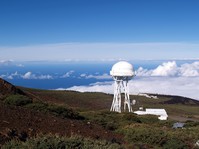
[jpg] DOT closed
2005 A. Kucera
The oceanic cloud layer is well below the DOT's altitude of 2350m during much of the year. The black area at the upper right marks the upper range of a huge downslope forest fire in September 2005.
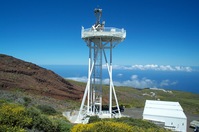
[jpg] DOT in June
2004 R.H. Hammerschlag
The DOT opened up in June when the codeso blossoms yellow. This broom improves the observing conditions by insulating the volcanic soil from solar heating.
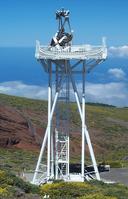
[jpg] DOT in June
2004 R.H. Hammerschlag
Same photograph, cut-out.

[tif] DOT on tower
2005 P. Suetterlin
View to the Northwest. The DOT tower is 15m high. The fold-away canopy is opened. The white box in he foreground houses the water tank for the prime-focus cooling.
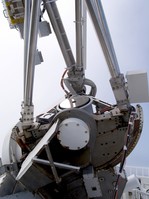
[jpg] DOT mirror
2005 A. Kucera
DOT mirror in its sturdy mount. There is room for a larger mirror - you are welcome to fund one!
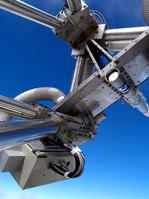
[jpg] DOT focus
2005 A. Kucera
The prime-focus, a water-cooled mirror bouncing most of the 2-cm solar image out of the telescope while transmitting the field of view through the small hole.
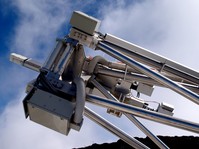
[jpg] DOT top
2005 A. Kucera
The DOT's business end with filters and cameras. The hoses are for air suction.
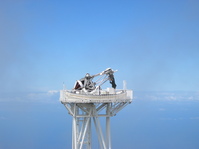
[jpg] DOT with Hammerschlag
2004 S. Rondi
R.H. Hammerschlag designed and built the DOT including its tower and fold-away canopy. Here he is seen closing the telescope in the afternoon.
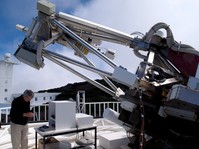
[jpg] DOT with Hammerschlag
2005 A. Kucera
Close-up of R.H. Hammerschlag at the end of observing.
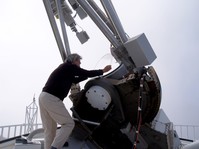
[jpg] Hammerschlag with mirror cover
2005 A. Kucera
R.H. Hammerschlag covering the mirror at the end of the day.
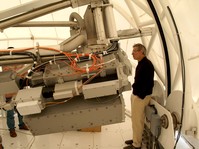
[jpg] Hammerschlag with parked DOT
2005 A. Kucera
R.H. Hammerschlah with the top of the DOT in parked position. The orange cables are the optical fibers transfering the images to the Swedish telescope building.
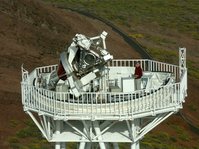
[jpg] DOT with Hammerschlag
2005 D. Torgerson
R.H. Hammerschlag opening up in the morning - a daily chore, as is closing at sunset. The rest of the day the DOT is controlled from the nearby building of the Swedish 1-m Solar Telescope.
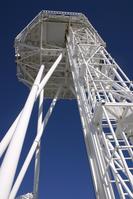
[jpg] DOT tower + platform
2005 T. van Werkhoven
The DOT tower consists of 8 tubular legs arranged in four triangles. Under varying wind loads, they maintain parallel motion of the platform so that the telescope does not suffer from tilt perturbations. To the right is the independently mounted elevator cage.
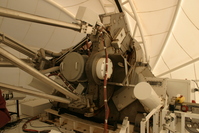
[jpg] DOT mirror mount
2005 T. van Werkhoven
The DOT has an equatorial or parallactic mount, rotating in hour angle around an axis parallel to the earth's axis, and in declination perpendicular to it. This classical arrangement has two major advantages: the solar image does not rotate with time, and the instrumental polarisation does not vary with time enabling precise calibration.
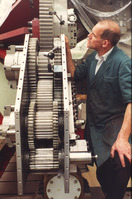
[jpg] DOT gears
1993 R.H. Hammerschlag
DOT technician P.W. Hoogendoorn with one of the DOT jour angle gear trains. Since the DOT is mounted without shielding on an open tower, it is subject to strong wind buffeting. Special self-aligning gears of heavy construction avoid telescope shake.
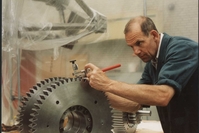
[jpg] DOT gear teeth.
1991 R.H. Hammerschlag
P.W. Hoogendoorn checking each tooth on one of the DOT gear wheels. It is essential that all teeth lash together over their full length so that the telescope cannot pivot around a single point.
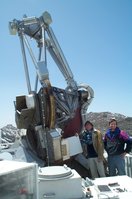
[jpg] DOT close-up.
2002 R.H. Hammerschlag
The DOT photographed close-up, with F.C.M. Bettonvil and P. Suetterlin. The primary solar image is visible on the heat reject mirror in the telescope top.
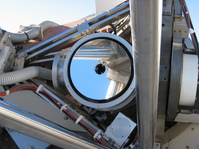
[jpg] DOT primary mirror
2005 T. van Werkhoven
The DOT's primary mirror has 45cm diameter. There is space for a much larger mirror, up to 140cm - see the last picture below.
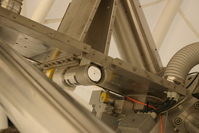
[jpg] DOT primary focus
2005 T. van Werkhoven
The DOT's business end. The primary image (diameter 2 cm) is mostly reflected away with the water-cooled mirror seen here. The small hole in itscenter transmits the beam used for imaging. The latter is sequentially split between the different wavelengths that feed the six DOT cameras. The digital images are transported via optical fiber to the Swedish telescope building, and from there to the DOT Speckle Processor.
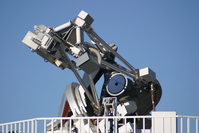
[jpg] DOT observing
2005 T. van Werkhoven
The DOT while observing. The canopy is folded flat, the telescope points to the sun. Its top end splits the primary beam between the G-band camera at the end of the on-axis tube (with white cap) and the other five cameras in boxes mounted besides the incoming beam, seen here at left. They contain special filters to select different wavelengths, including large complex Lyot filters for the hydrogen Balmer alpha line and the main resonance line of ionised barium. The white camerabox in front contains the focus monitor. The shadow pattern seen on the primary mirror defines the DOT aperture. The on-axis tube housing the focusing sled and the G-band filter and camera casts a shadow within the central hole of the mirror. The shadow band across the mirro and the two perpendicular bands are cast by the heavy prime-focus support plates seen in the telescope top. The first one als houses water channels for prime-focus heat stop cooling. The wide hoses serve for air suction around prime focus.
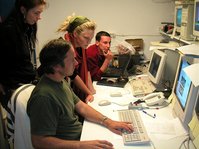
[jpg] DOT control room
2004 R.J. Rutten
The DOT control room is in the basement of the Swedish solar telescope building, adjacent to the control room of the Swedish 1-m Solar Telescope which facilitates co-pointed targeting. On this photograph chief DOT observer P. Suetterlin explains the DOT control displays to students D. de Rooij and S. de Mink, with guest observer S. Rondi watching.
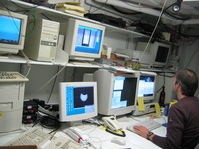
[jpg] DOT controls
2005 T. van Werkhoven
P. Suetterlin observing the partial eclipse of October 3, 2005. Upper left screen: seeing monitor. Upper center screen: phase-diverse focus monitor. Lower left screen: full-disk pointing monitor. Lower right screens: camera control. Bottle of wine: for Fried parameter 20 cm.
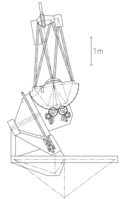
[png] DOT sketch
1975 R.H. Hammerschlag
The DOT is an equatorially mounted reflector. The structure is open to permit wind flushing of the primary mirror. The focal length of the parabolic primary is 2m; its diameter is 45cm. The solar image has a diameter of 2cm and is mostly reflected away with a water-cooled mirror in prime focus. A small hole transmits the field of interest to the multi-wavelength re-imaging system in the telescope top. In this sketch the telescope is pointed at the sun at local noon on June 21. The parallactic mount consists of a full-circle hour-angle wheel (seen edge-on) and a half-circle declination wheel (face-on). A three times larger mirror than the present 45-cm primary can be accommodated. The slender on-axis tube in the telescope top houses the prime-focus hardware and the G-band channel. The remainder of the multi-wavelength imaging system and the focus monitor are housed to the left and the right of the incoming beam, respectively.
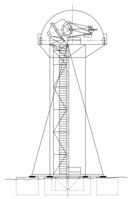
[png] DOT tower sketch
1975 R.H. Hammerschlag
The DOT tower is 15m high. It is of open construction to minimise obstruction to the ambient air flow in the trade winds. In the best observing conditions these come from the North (to the right). From the bottom up: foundation consisting of four 2-m deep blocks of 25 cubic meter concrete each; tower with two vertical leg triangles seen face-on, the other two edge-on; disconnected open-frame stairs and elevator; telescope in parked position; closed canopy. At about 13 tons the tower weighs less than the telescope on top of it (about 17 tons), but nevertheless provides very high pointing stability in strong wind buffeting through its special leg arrangement. Each of the two parallel triangle pairs inhibits tipping of the platform but permits only plane lateral motion. That is OK since the sun is an object at infinity.

[png] DOT re-imaging system
2002 F.C.M. Bettonvil
Sketch of the DOT multi-wavelength re-imaging system. The G band camera is mounted on-axis behind the primary focus with heat rejection mirror. All other cameras are fed with beams reflected to locations besided the incoming beam, here indicated schematically. Dichroic beam splitters divide the light between blue and red parts of the spectrum. The two Lyot filters for Halpha and the Ba II line are large boxes containing sequences of calcite crystals.
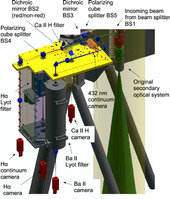
[png] DOT re-imaging system
2002 A. Jaegers
Detailed design of the multi-wavelength imaging system. There are field lenses and re-imaging lenses in addition to the various filters. The latter are positioned telecentrically, with the pupil at infinity. The Ba II 4554 filter has additional optics for polarimetry not shown here.
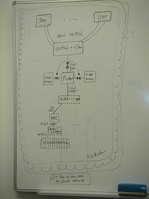
[jpg] DOT Speckle Processor
2002 R.J. Rutten
The original design sketch of the DOT Speckle Processor, signed by artist A.G. de Wijn.
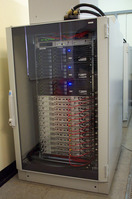
[tif] DOT Speckle Processor
2005 P. Suetterlin
All DOT images are corrected for the wavefront perturbations imposed by the earth's atmosphere through speckle reconstruction. This is a highly demanding comptutational technique which converts one "speckle burst" of 50-100 rapidly taken short exposures into a single sharp image. Thanks to funding by NWO (the Dutch funding agency for scientific research) we operate this advanced DOT Speckle Processor since 2005. It has dramatically speeded up the DOT high-resolution movie production.
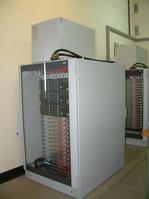
[jpg] DOT Speckle Processor
2005 F.C.M. Bettonvil
Both racks of the DOT Speckle Processor. They house 70 Xeon CPUs, all individually water-cooled, in two compact racks. An elaborate cooling system stores the heat from the processors and disk drives in a 5000-liter water tank, from which it is released by fan cooling at sunset when it disturbs neither daytime nor nighttime observing. It is located in the nearby building of the Automatic Transit Circle (formerly the Carlsberg Meridian Telescope), and is fed from the Swedish solar telescope building by optical fibers.
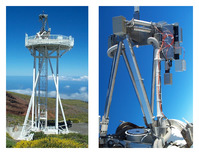
[png] DOT+tower, closeup
Combination figure
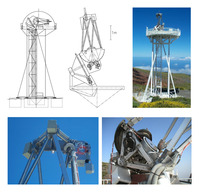
[png] diagrams, full, top, mirror
Combination figure
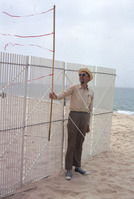
[jpg] DOT past: C. Zwaan
1973 R.H. Hammerschlag
Our past. This photograph taken on an island beach near Faroe, Portugal, epitomizes the start of the DOT. Cornelis Zwaan was the chairman of the Working Group on Site Selection of the Joint Organisation for Solar Observations and in charge of finding the best location for high-resolution solar physics in Europe. The answer: extinct volcanoes on the Canary Islands. The search inspired Zwaan to the principle of an open wind-flushed telescope, and to suggest to Hammerschlag to design and build the DOT. Just before his untimely death in 1999, he initiated the foundation SOZOU which co-funds our efforts. You are most welcome to contribute to it (P.Hoyng@sron.nl).
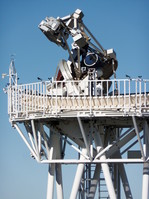
[jpg] current DOT
The DOT when used by the PROM consortium on an NSF grant.
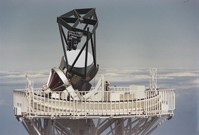
[jpg] DOT future: DOT++
2003 A. Jaegers
Our future? This design drawing superimposed on a DOT photograph shows what we would like: replace the current 45 cm mirror by a 140 cm one. The sharpness of a telescope increases with its diameter; this increase will therefore triple the DOT's angular resolution. The upgrade is straightforward, needing just the mirror and a new telescope top but no change to the tower, platform, telescope mount, canopy, or the multi-channel speckle imaging system. However, since the detector-defined field of view then gets nine times smaller to accommodate the smaller resolution elements, we would also like to replace the current 1.3 Mpx cameras with 12 Mpx ones. Both upgrades are a matter of money. You are most welcome to help fund such DOT tripling.
>>> If you want a superb telescope named after you, this is your chance! <<<
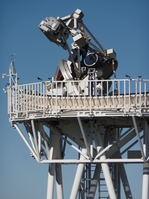
2010-DOTkop-orig